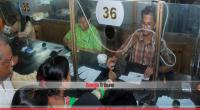 To search for gas, BAPEX carried out exploration in ten new sites in as many years with success in only two.
To search for gas, BAPEX carried out exploration in ten new sites in as many years with success in only two.
The picture of oil-gas reserve on land is rather dismal.
It’s speculated from the overall situation that there isn’t any large gas deposit on land.
Former Petrobangla chairman Hossain Monsur says, “Since gas reserve has fallen, we have begun importing LNG; there is the possibility of finding gas at sea but it’s risky as if no gas is found then the cost for exploration will be a burden on Bangladesh.”
In a recent report, Petrobangla’s hydro carbon unit said that by 2030, gas reserve will be exhausted.
That’s why liquefied natural gas or LNG terminals have been established with initiatives taken to construct three terminals capable of supplying 3000 million cubic feet of gas every day.
“No one can say with certainty if gas reserves exist or not; an idea can be formed through two dimensional and three dimensional surveys,” says energy expert Shamsul Alam.
A “hide and seek game is being played” with gas reserves for quite some time and presenting a state of crisis, LNG is being imported from oversea, he deplored.
BAPEX started excavating in Sundalpur, Noakhali in December 2010 and in August the following year, Petrobangla said gas has been found.
At that time, it was hoped that 12 million cubic feet of gas will be found daily but after seven years six months, the daily output is 7 million cubic feet.
In 2012, a well was declared abandoned in Kapasia, Gazipur.
In 2004, Petrobangla said that there is 4 to 4.5 TCF of gas reserved in Sunetra gas-field and a two dimensional survey was carried out in 2012 though in March, 2013, it was declared that no gas was found.
In January 2014, BAPEX began excavating in Rupganj and found gas at a depth of 3615 metre. The gas was supposed to be excavated but the gas reserve was so frugal that work never began.
BAPEX also failed to find gas in Salda-4 of Brahmanbaria and Cosba-1 wells in 2018.
Former MD of BAPEX, Murtaza Ahmed Faruk Chisti, said: “renewed exploration has to be carried out through strategic planning; work can be carried out in the hill tracts and the oceans.”
 Business
Business
41176 hour(s) 37 minute(s) ago ;
Morning 11:31 ; Saturday ; Jun 28, 2025
Gas exploration needs strategic approach: Experts
Send
Shanchita Shitu
Published : 09:40, Feb 28, 2019 | Updated : 23:30, Feb 28, 2019
Published : 09:40, Feb 28, 2019 | Updated : 23:30, Feb 28, 2019
0 ...0 ...
/tf/zmi/
Topics: Top StoriesExclusive
- KOICA donates medical supplies to BSMMU
- 5 more flights to take back British nationals to London
- Covid19: Rajarbagh, Mohammadpur worst affected
- Momen joins UN solidarity song over COVID-19 combat
- Covid-19: OIC to hold special meeting
- WFP begins food distribution in Cox’s Bazar
- WFP begins food distribution in Cox’s Bazar
- 290 return home to Australia
- Third charter flight for US citizens to return home
- Dhaka proposes to postpone D8 Summit
Unauthorized use of news, image, information, etc published by Bangla Tribune is punishable by copyright law. Appropriate legal steps will be taken by the management against any person or body that infringes those laws.
Bangla Tribune is one of the most revered online newspapers in Bangladesh, due to its reputation of neutral coverage and incisive analysis.
F R Tower, 8/C Panthapath, Shukrabad, Dhaka-1207 | Phone: 58151324; 58151326, Fax: 58151329 | Mob: 01730794527, 01730794528






